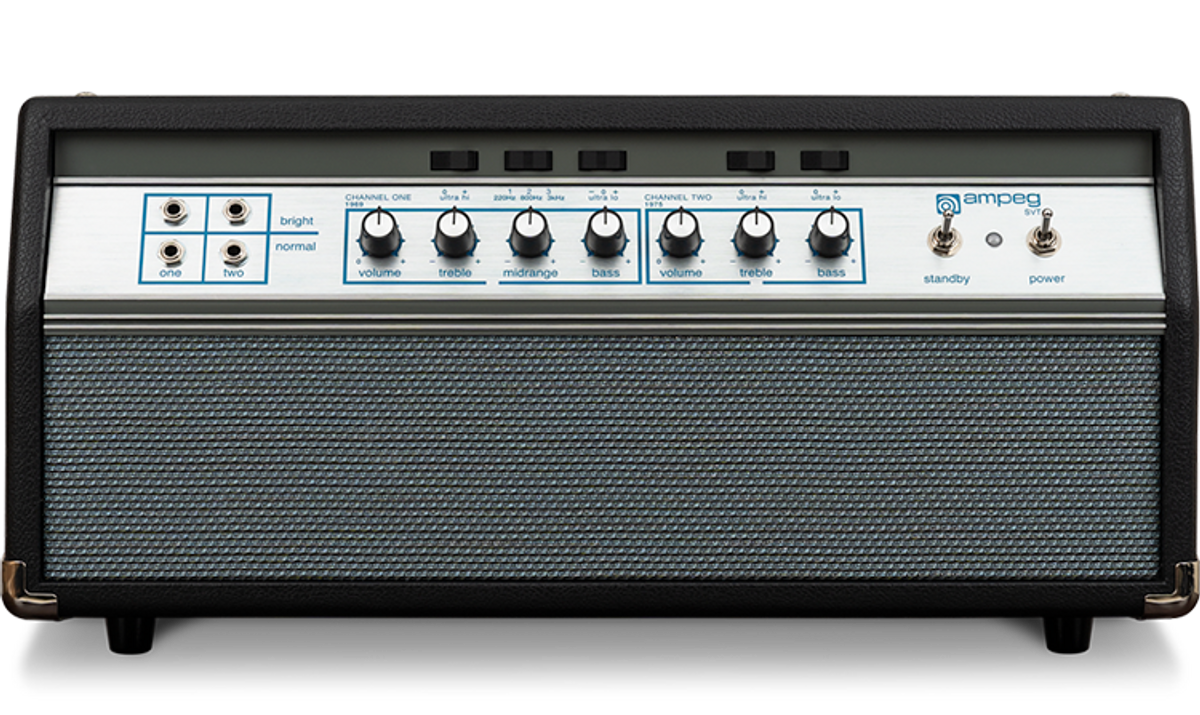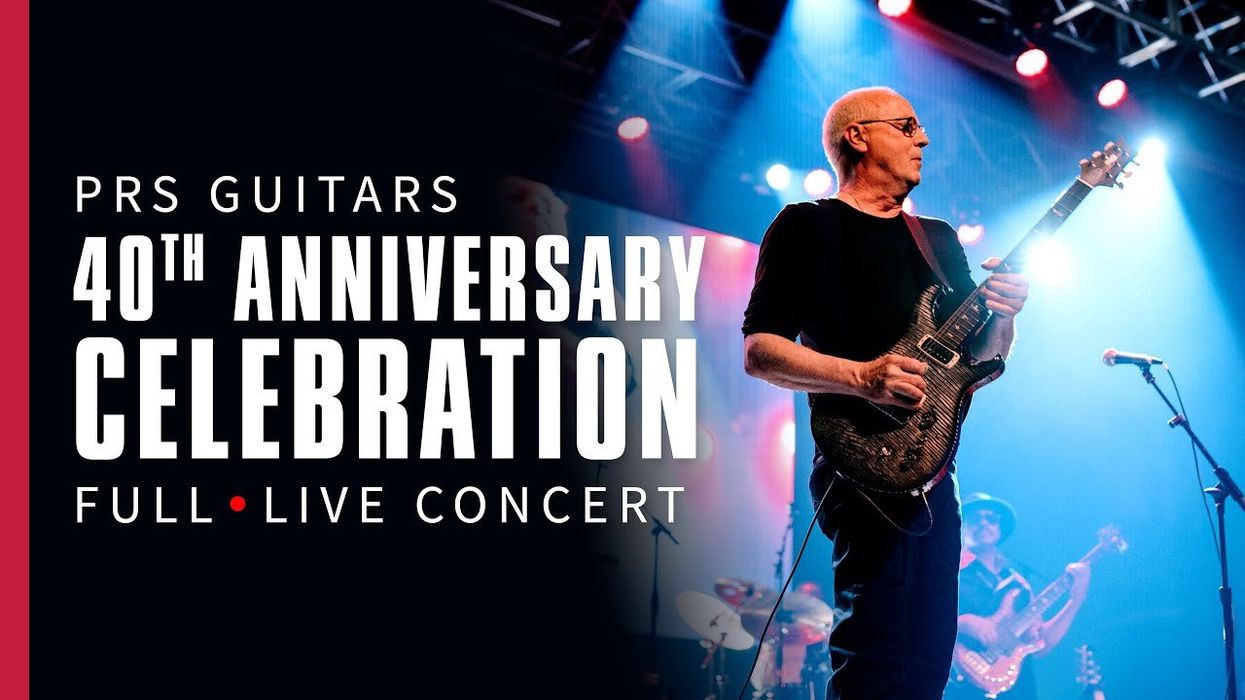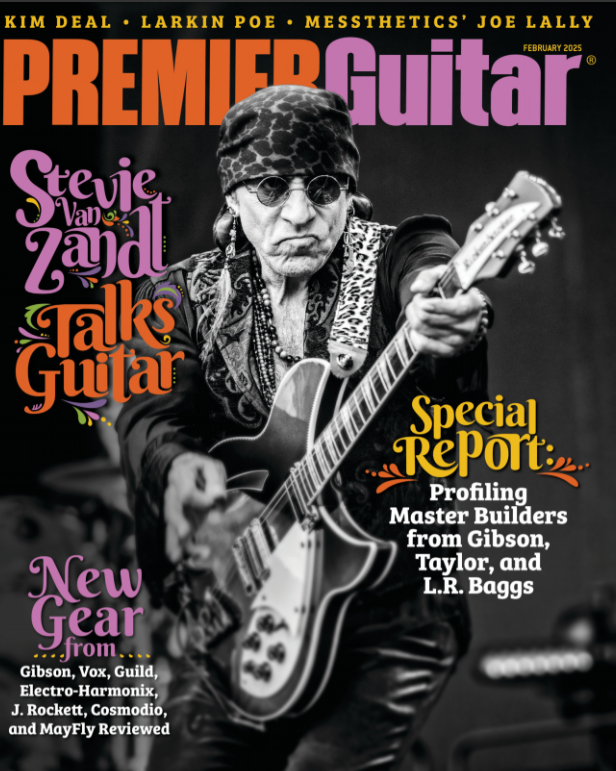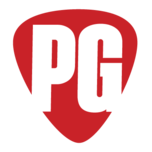
For at least a decade, the classic Ampeg SVT was the dominant bass amp for power and tone.
From the giant, hefty beasts of yore to their modern, ultra-portable equivalents, bass amps have come a long way. So, what's next?
Bassists are often quite well-informed about the details of their instruments, down to the finest technical specs. Many of us have had our share of intense discussions about the most minute differences between one instrument and another. (And sometimes those are interrupted by someone saying, "It's all in the fingers.") But right behind our backs, at the end of our output cables, there is a world of tone-shaping that we either simply ignore or just don't want to dive into too deeply. Turning a gear discussion from bass to amp is a perfect way to bring it to an abrupt end.
Since the beginning of our instrument's history, bassists have faced the fundamental and existential problem of trying to be heard. It's solved now, but too many players don't seem to be interested in how we got here. And it's not just bassists. Even some amp manufacturers haven't been concerned with the details. A few readers might remember that in my September 2019 column, I discussed class-D amp technology. As part of my research, I called a very respected amp manufacturer to get his insight into class-D technology. His stunning response was: "We simply checked some Asian-made modules and chose the one we thought sounded best, but I don't know and never cared how they work." Even the offer of a short technical introduction was met with blissful ignorance. So, if anyone thinks they don't need to know how their amp works, at least you're in good company!
Over the course of the last 80 years or so, the fundamental technology used in our amps has been replaced—and not just once. The technological changes came in several waves and another might be on the way.
Here we are now after this last wave of amp-tech: down from 300 watts at 40 kilograms or 88 pounds in the 1970s, to 500 to 1000 watts at 1 to 3 kilograms or 2 to 7 pounds today.
For the greater part of the last century, bass amps relied on tube circuitry, and it took until the middle of the century to make decently powerful, but heavy and fragile, amps. Unfortunately, guitarists used the same technology—and sometimes even the amps that were initially made for us. (Remember that our low-end needs about 10 times the power of a guitar amp to cut through!) So, as their volume increased, our need for more power just became greater. Our problem remained until the 1960s when amps like Ampeg's B-15 Portaflex and SVT entered the scene. High-output amplification manufacturers sprouted everywhere, enabling loud rock bands to move from clubs to stadiums.
Though the transistor quietly altered the landscape of radios and small solid-state amps during the early 1950s, it took until the late '60s before this technology made it into our rigs. The first companies to make solid-state amps were those who possessed a higher engineering background. Vox, for example, released one of the first solid-state bass amps, thanks to their prior experiences with solid-state circuits from their organs. Many smaller companies soon followed, although most earned a reputation for unreliability. But the technology developed at a breathtaking pace.

This Ashdown Little Giant is more powerful than the mighty SVT at less than 1/10th the weight!
Photo courtesy of wikimedia.com
During the 1980s, clean and powerful hi-fi-esque synth sounds became trendy. This benefitted bassists with the development of clever tone-shaping options, hybrid circuits with tube preamps, bi-amping, internal DIs, and even more power.
Once we were sure to be heard, it was time to look for other advantages, like reduced weight and size, and along came another wave of new amp technology: class D. (See my column "Signal Processing in Class-D Amps," September 2019.) The basic principle behind class-D technology is pulse width modulation (PWM), which sounds as if those with higher engineering skill would once again be in the lead. Instead, there are just a few manufacturers building class-D power modules, and amp builders can use those as the foundation of their own amps. Just get one of the modules, which come in different power ratings, add a power supply and a tone-shaping circuit, and you're done. With several competing manufacturers offering identical power amps, the individual strengths have fully shifted to the qualities of their tone-shaping circuitry and other add-ons or gimmicks.
Here we are now after this last wave of amp tech: down from 300 watts at 40 kilograms or 88 pounds in the 1970s, to 500 to 1000 watts at 1 to 3 kilograms or 2 to 7 pounds today. What could be the next move? It looks as if the power-to-weight ratio has reached an end for quite some time, but tone-shaping capabilities in preamps might shift from classic circuitry to profiling or modeling amps as a fourth wave. And this time it's clearly engineering competence that will make the difference. Can you imagine what instruments we'd be playing today if our basses had made similar progress?
- Bass Bench: Tracing the Origins of the Fretless Electric Bass ... ›
- Consider the Mighty Bass Speaker - Premier Guitar ›
- All About Speakers - Premier Guitar ›
- Will the Electric Bass Continue To Evolve? - Premier Guitar ›
Building upon the foundation of the beloved Core Collection H-535, this versatile instrument is designed to serve as a masterpiece in tone.
The new model features striking aesthetic updates and refined tonal enhancements. Crafted at the iconic 225 Parsons Street factory, home to other world-famous models like the H-150, H-157, and H-575 - the H-555 continues to exemplify the very best of American craftsmanship.
The Core Collection H-555 features a set of Custom Shop 225 Hot Classic Humbuckers, meticulously wound in-house with carefully selected components, and voiced to deliver added punch and richness while preserving exceptional dynamics and touch sensitivity. Seamlessly complementing the H-555’s semi-hollow construction, they blend warmth and woodiness with refined, articulate clarity.
The Core Collection H-555’s aesthetic has been elevated with multi-ply binding on the body, headstock, and pickguard. Its neck, sculpted in a classic ’50s profile, delivers effortless comfort and is adorned with elegant block inlays, seamlessly blending style with playability. Gold hardware complements the aesthetic, exuding elegance while presenting the H-555 as a truly premium and versatile instrument for the discerning player.
Available in Ebony and Trans Cherry, each Core Collection H-555 is beautifully finished with a nitrocellulose vintage gloss that features a subtle shine and gracefully ages over time. An Artisan Aged option is also available for those seeking an authentically well-loved look and feel, achieved through a meticulous, entirely hand-finished aging process. The new Core Collection continues Heritage’s tradition of world-class craftsmanship, offering a true masterpiece in tone and design for discerning players. Each guitar is shipped in a premium Heritage Custom Shop hard case.
Key Features
- Finest Tonewoods: Laminated highly figured Curly Maple (Top & Back) with solid Curly Maple sides
- Heritage Custom Shop 225 Hot Classic Humbuckers: Designed and wound in-house
- Headstock: Multi-ply bound headstock, featuring a Kite inlay, 3×3 tuners laser-etched with Heritage graphics
- Neck Profile: Comfortable ’50s C-shape for a vintage feel
- Bridge: Tune-O-Matic with aluminum stopbar tailpiece for enhanced sustain
- Made in the USA: Crafted at 225 Parsons Street
For more information, please visit heritageguitars.com.
Ariel Posen and the Heritage Custom Shop Core Collection H-555 - YouTube
Enjoy the videos and music you love, upload original content, and share it all with friends, family, and the world on YouTube.Watch the official video documenting the sold-out event at House of Blues in Anaheim. Join Paul Reed Smith and special guests as they toast to quality and excellence in guitar craftsmanship.
PRS Guitars today released the official video documenting the full night of performances at their 40th Anniversary celebration, held January 24th in conjunction with the 2025 NAMM (The National Association of Music Merchants) Show. The sold-out, private event took place at House of Blues in Anaheim, California and featured performances by PRS artists Randy Bowland, Curt Chambers, David Grissom, Jon Jourdan, Howard Leese, Mark Lettieri Group, Herman Li, John Mayer, Orianthi, Tim Pierce, Noah Robertson, Shantaia, Philip Sayce, and Dany Villarreal, along with Paul Reed Smith and his Eightlock band.
“What a night! Big thanks to everyone who came out to support us: retailers, distributors, vendors, content creators, industry friends, and especially the artists. I loved every second. We are so pleased to share the whole night now on this video,” said Paul Reed Smith, Founder & Managing General Partner of PRS Guitars. “I couldn’t be more proud to still be here 40 years later.”
With nearly 1,400 of the who’s who in the musical instrument industry in attendance, the night ended with a thoughtful toast from PRS Signature Artist John Mayer, who reflected on 40 years of PRS Guitars and the quality that sets the brand apart. “The guitars are great. You can’t last 40 years if the guitars aren’t great,” said Mayer. “Many of you started hearing about PRS the same way I did, which is you would talk about PRS and someone would say ‘They’re too nice.’ What’s too nice for a guitar? What, you want that special vibe that only tuning every song can give you on stage? You want that grit just like your heroes … bad intonation? The product is incredible.”
Be sure to locate your sample library where it can be quickly referenced on your DAW.
Improve your recordings using your own samples. Bryan Clark, house producer at Nashville’s Blackbird Studio, tells you how to take the final steps in building your own sample library.
Mastering the sample import process in your chosen DAW can significantly enhance your creativity and streamline your workflow. With a clear understanding of the tools and techniques available, you will be better equipped to bring your musical ideas to life and make your productions stand out.
This month, we finish up a three-part series on creating your own sample libraries. In this final installment, I’m going to give you the basic ways to import your samples into various popular DAWs. Each one has its unique workflow and user interface, but the fundamental process remains very similar. This Dojo guide will cover how to import samples into Ableton Live, LUNA, Logic Pro, Pro Tools, and Studio One.
Ableton Live
Steps to Import Samples
Drag and Drop: Simply locate the sample file in your computer’s file explorer, then drag and drop it directly into an audio track in the session or arrangement view.
Browser Window: Use Ableton’s built-in browser (on the left-hand side). Navigate to the sample’s location on your hard drive, then drag it into the workspace.
Create a Simpler or Sampler Instrument: Drag the sample into a MIDI track with Simpler or Sampler loaded. This allows you to trigger the sample using MIDI notes.
Tips: Use the warp feature for time-stretching and syncing samples to your project’s tempo.
Organize your samples into collections using the “Add Folder” option in the browser.
LUNA
Steps to Import Samples
Drag and Drop: Drag the sample from your file explorer directly into the timeline. Then hold the CTRL key down, click on the end of the loop, and drag it to the length it needs to be.
Browser/Workspace: Use the media browser to navigate to your sample’s location on your hard drive. Drag it into an audio track in your session.
Audio Track Import: Right-click on an empty area in the timeline or a track and select “Import Audio” to locate and add your sample.
Tips: Use LUNA’s built-in varispeed capabilities to match your sample to the session’s tempo.Logic Pro
Steps to Import Samples
Drag and Drop: Drag the sample from the Finder directly into an audio track in the workspace.
File Browser: Use the file browser (accessible via the media sidebar or “F” key) to locate and drag samples into the timeline.
Quick Sampler: Drag your sample onto a MIDI track with the Quick Sampler plugin loaded. This lets you play the sample chromatically.
Tips: Use Logic’s flex time feature to sync samples to your project’s tempo. Organize samples into Logic’s library for quick access.Pro Tools
Steps to Import Samples
Import Audio Dialog: Go to File > Import > Audio; then locate your sample and click “Convert” or “Add” to bring it into the session.
Drag and Drop: Drag the sample directly from your file explorer into an audio track.
Workspace Browser: Use the workspace (accessible via Window > New Workspace) to locate your sample. Drag it into your session.
Tips: Use the elastic audio feature for tempo matching and pitch adjustments.
Place your samples into playlists for efficient access during editing.
Studio One
Steps to Import Samples
Drag and Drop: Drag your sample directly from your file explorer into the timeline or browser.
Browser: Open Studio One’s browser (on the right-hand side), navigate to the folder containing your sample, and drag it into your project.
Sampler Track: Drag the sample onto a MIDI track, and use the Sample One sampler for additional manipulation.
Tips: Enable the “Stretch Audio Files to Song Tempo” option in the browser for automatic tempo synchronization. Create sample folders within Studio One’s browser for quick access.General Best Practices
Regardless of the DAW you use, it is important to maintain a smooth and efficient workflow. Organize your sample library with clear folder names and categories to make locating files easy (see last month’s installment for detailed strategies). Where possible, learn DAW-specific shortcuts for importing and editing samples to save time. Always check if your DAW offers a feature to sync the sample’s tempo to your project to ensure seamless integration. Finally, regularly back up your sample collection to avoid losing important audio files and preserve your creative assets! Seriously. Do it now.
Next month, we’re off to “console” land and I’ll be investigating console emulations (hype or not?), summing bus processors, and more to give you a more “studio” sound. Until then, blessings and namaste.
Stretching the boundaries of reverb’s realm through dynamic and pitch control.
Nice core reverb sounds. Invites cool compositional and arrangement directions. High quality.
If you lack patience, it will be hard to unlock its coolest secrets.
$329
Gamechanger Audio Auto Reverb
gamechangeraudio.com
When the first Moog synthesizer appeared, it freaked out a lot of musicians—not least for the way it blurred the divisions between instruments and their roles. Was it percussion? A keyboard? A reed instrument? Many effects makers build from this philosophical foundation. The Latvian company Gamechanger often seems to revel in it—an attitude that’s manifest in the company’s Auto Series pedals, which includes the Auto Reverb.
There’s no reason you can’t use the Auto Reverb in a very straightforward fashion. The plate, spring, and hall settings are all very nice digital representations of their analog inspirations—and I’d be perfectly happy playing an instrumental surf set with the spring mode, for instance. But because you can control the parameters like the reverb’s level, decay, tone, and the filter with changes in pitch and dynamics, the Auto Reverb can function in highly orchestral ways, transforming itself from subtle to outlandish as a musical piece shifts in intensity or rises from low to high keys toward a blurred, hyper-spacious climax. While these attributes make the Auto Reverb a great fit for prepared guitar and conceptual pieces—and invites many themes and compositional ideas within those forms—it can just as easily be configured to create an especially dynamic and dramatic pop song arrangement on stage or in the studio that might otherwise be relegated to automations within a DAW. It’s fun to use, if not always intuitive. But knowing its ways can expand your musical options significantly.







